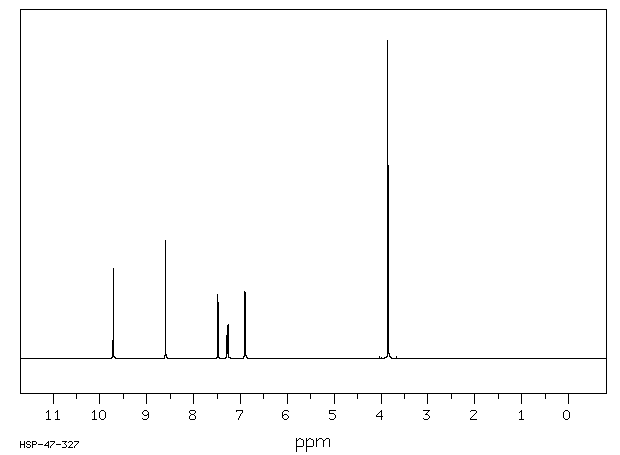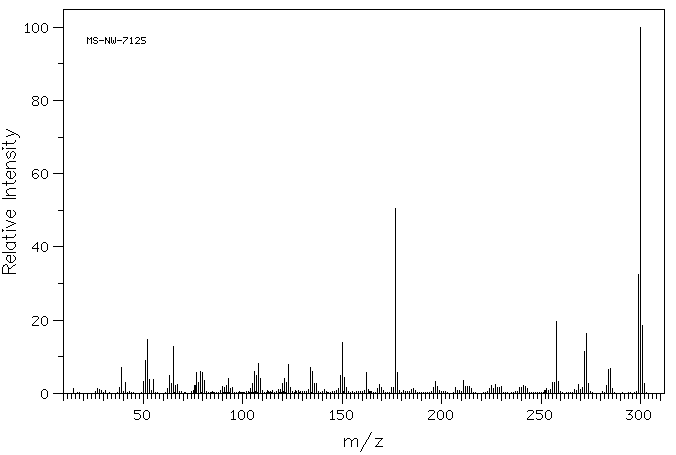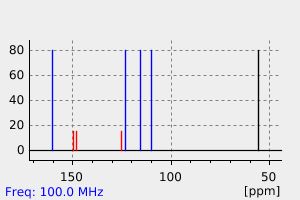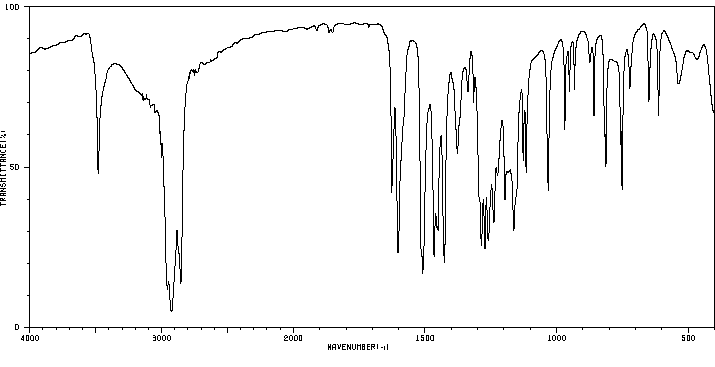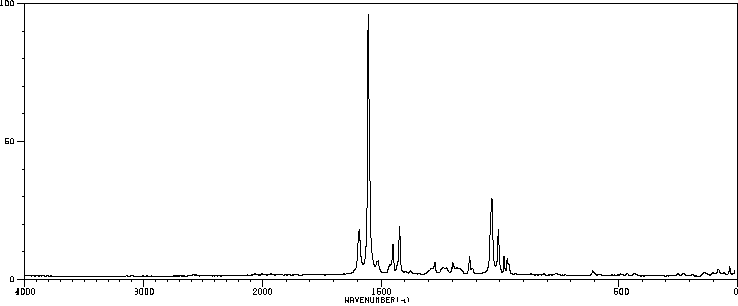4-hydroxy-3-methoxybenzaldehyde azine | 1696-60-2
中文名称
——
中文别名
——
英文名称
4-hydroxy-3-methoxybenzaldehyde azine
英文别名
4,4’-((1E,1’E)-hydrazine-1,2-diylidenebis(methanylylidene))bis(2-methoxyphenol);Vanillin azine;4-[(E)-[(E)-(4-hydroxy-3-methoxyphenyl)methylidenehydrazinylidene]methyl]-2-methoxyphenol
CAS
1696-60-2
化学式
C16H16N2O4
mdl
——
分子量
300.314
InChiKey
GGQDJSIYHIRXDW-BEQMOXJMSA-N
BEILSTEIN
——
EINECS
——
-
物化性质
-
计算性质
-
ADMET
-
安全信息
-
SDS
-
制备方法与用途
-
上下游信息
-
文献信息
-
表征谱图
-
同类化合物
-
相关功能分类
-
相关结构分类
物化性质
-
熔点:179-181 °C(lit.)
-
沸点:441.54°C (rough estimate)
-
密度:1.1782 (rough estimate)
计算性质
-
辛醇/水分配系数(LogP):2.5
-
重原子数:22
-
可旋转键数:5
-
环数:2.0
-
sp3杂化的碳原子比例:0.12
-
拓扑面积:83.6
-
氢给体数:2
-
氢受体数:6
安全信息
-
危险品标志:Xi
-
安全说明:S26
-
危险类别码:R36/37/38
-
WGK Germany:3
-
海关编码:2928000090
SDS
上下游信息
-
上游原料
中文名称 英文名称 CAS号 化学式 分子量 香草醛 vanillin 121-33-5 C8H8O3 152.15
反应信息
-
作为产物:参考文献:名称:Schiff碱衍生物作为多功能药物治疗阿尔茨海默氏病的设计,合成和生物学评估摘要:合理设计,合成和评估了一系列席夫氏基础衍生物,将其作为治疗阿尔茨海默氏病(AD)的多功能药物。结果表明,化合物3b是新型多功能剂。它是一种高度选择性的单胺氧化酶-B抑制剂(IC 50 = 8.4 nM),这已在对接研究中得到了解释。化合物3b中也是抗氧化剂(2.3当量)和能抑制显著自诱导甲β 1-42聚集(31.8%)。同时,化合物3B是一个选择性的金属螯合剂和能抑制铜2+诱导的阿β 1-42聚集(62.3%)。此外,化合物3b对H 2 O 2诱导的PC12细胞损伤具有良好的神经保护作用。更重要的是,该化合物具有良好的血脑屏障通透性和类药物特性。因此,化合物3b是一种有前途的多靶点活性分子,为抗AD的药物发现过程中的进一步研究提供了有吸引力的起点。DOI:10.1007/s00044-020-02666-6
文献信息
-
The Reaction of Hydrazine with α‐Cyanocinnamate Esters: A Caveat作者:Paul J. Erdman、Jimmy L. Gosse、Jamey A. Jacobson、David E. LewisDOI:10.1081/scc-120028648日期:2004.12.31Abstract α‐Cyanocinnamate esters react with hydrazine to give initial products of conjugate addition that then undergo a fragmentation to give the azine of the carbonyl precursor to the starting ester, rather than intramolecular aminolysis to give the pyrazolidinone.
-
Method for dyeing dry hair申请人:Novozymes A/S公开号:US20020007524A1公开(公告)日:2002-01-24The present invention relates to methods for dyeing keratinous fibers, without significantly damaging the hair. According to the method of the present invention the fibers are treated in a dry state by contacting said fibers with at least one oxidoreductase and at least one dye precursor. In this way it is possible to dye, e.g. human hair, in a simple and efficient manner.本发明涉及一种染色角蛋白纤维的方法,而不会显着损伤头发。根据本发明的方法,通过将纤维与至少一种氧化还原酶和至少一种染料前体接触,以干燥状态处理纤维。通过这种方式,可以简单高效地染色,例如人类头发。
-
Indicating devices based on lateral diffusion of a mobile phase through a non-porous stationary phase申请人:JP LABORATORIES, INC公开号:US10451595B2公开(公告)日:2019-10-22This invention relates to indicating devices, such as time-temperature indicators based on lateral diffusion of a vapor of a solid and/or liquid mobile phase (e.g., a sublimeable dye or an activator) through a non-porous stationary phase, such as a thin layer of a polymeric material. The lateral diffusion of the mobile phase creates a noticeable boundary in the stationary phase whose movement depends upon processes, such as time and temperature.本发明涉及指示装置,如基于固体和/或液体流动相(如可升华染料或活化剂)的蒸汽通过无孔固定相(如聚合物材料薄层)的横向扩散的时间-温度指示器。流动相的横向扩散在固定相中形成一个明显的边界,其移动取决于时间和温度等过程。
-
Color changing steam sterilization indicator申请人:——公开号:US20030211618A1公开(公告)日:2003-11-13There is provided a device ( 10 ) for monitoring sterilization of a material with steam comprising at least one layer ( 20 ), having incorporated therein an isomeric indicator ( 22 ), capable of undergoing at least one color change and optionally a controller ( 23 ) for said indicator capable of influencing the time and temperature required for said color change when contact with steam. Composed of polymeric binder ( 21 ).提供了一个装置 ( 10 )用于监测用蒸汽对材料进行灭菌的情况,该装置包括至少一层( 20 ),其中含有异构指示剂 ( 22 20 ),其中包含一个异构指示器(22 23 控制器(23),该指示器能够在与蒸汽接触时影响上述颜色变化所需的时间和温度。由聚合物粘合剂 ( 21 ).
-
Thick radiation sensitive devices申请人:Patel N. Gordhanbhai公开号:US20050208290A1公开(公告)日:2005-09-22Described is radiation sensitive imaging and dosimeter composition ( 20 ) containing a radiation sensitive material ( 21 ), e.g., a diacetylene (R—C═C—C═C—R′, where R and R′ are substituent groups) or a radiochromic dye, a polymeric binder ( 22 ) and optionally a solvent ( 23 ) and/or an activator ( 24 ). Radiation sensitive materials are incorporated into a moldable or castable material and are molded or casted into shaped-articles ( 100 ), such as coatings, films, fiber, plaques, rods and blocks. Upon exposure to high-energy radiations, radiation sentitive material develops color thereby producing a visible image. Because of the higher thickness, a significantly lower dose of radiation can be monitored and an image is produced in three dimensions. Materials, processes and usages for thick radiation sensitive devices are described. A thick block can be used for monitoring radiation dosages in the three dimensions.
表征谱图
-
氢谱1HNMR
-
质谱MS
-
碳谱13CNMR
-
红外IR
-
拉曼Raman
-
峰位数据
-
峰位匹配
-
表征信息
同类化合物
(2-氯-6-羟基苯基)硼酸
黄柄曲菌素
高香草酸-d3
高香草酸-13C6
高香草酸
高香兰酸乙酯
高辣椒素II
高二氢辣椒素I
香草醛醛肟
香草醛苯腙
香草醛-甲氧基-13C
香草醛-(N-对甲苯基肟)
香草醛
香草酸肼
香草壬酰胺
香草基扁桃酸乙酯
香草吗啉
香草二乙胺
香兰素胺硬脂酸盐
香兰素胺硬脂酸盐
香兰素胺盐酸盐
香兰素丙二醇缩醛
香兰素13C6
香兰素-D3
香兰基乙基醚
香兰基丁醚
顺式-5-正十五碳-8'-烯基间苯二酚
顺式-1-(2-羟基-5-甲基苯基)-2-丁烯-1-酮
顺式-1-(2-羟基-4-甲氧基苯基)-2-丁烯-1-酮
顺-3-氯二氢-5-苯基呋喃-2(3H)-酮
雌二醇杂质1
降二氢辣椒碱
阿诺洛尔
阿瓦醇
阿普斯特杂质
间苯二酚双(二苯基磷酸酯)
间苯二酚-烯丙醇聚合物
间苯二酚-D6
间苯二酚
间苯三酚甲醛
间苯三酚二水合物
间苯三酚
间羟基苯乙基溴
间硝基苯酚
间甲酚紫钠盐
间甲酚与对甲酚和苯酚甲醛树脂的聚合物
间甲酚-D7
间甲酚-D3
间甲酚
间溴苯酚


